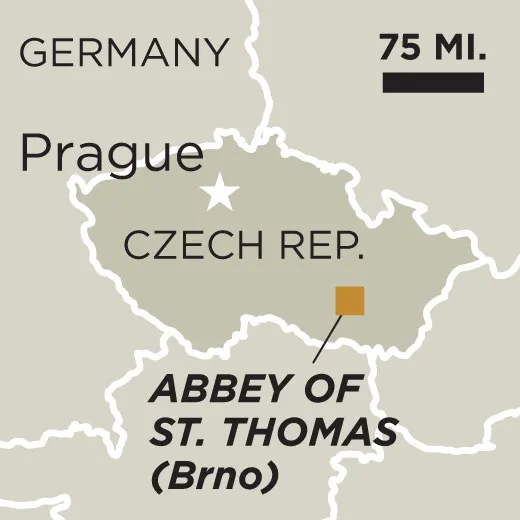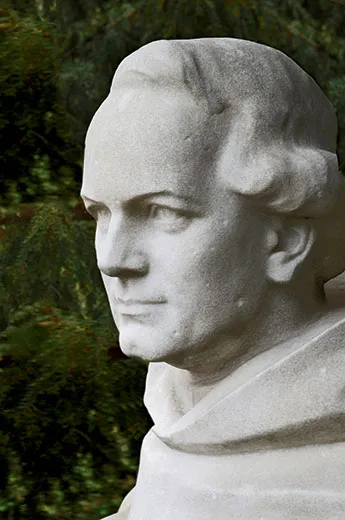Evolution World Tour: Mendel’s Garden, Czech Republic
At an abbey in the Czech town of Brno, a friar studied peas and laid the groundwork for modern genetics
For seven centuries, the skyline of Brno—the second-largest city in the Czech Republic—has been dominated by Spilberk Castle. Built on the summit of the highest hill in the city, it was one of Europe’s most notorious prisons, and a conspicuous warning to those who would oppose the rule of the Hapsburg dynasty.
Yet, for many, the most impressive site in Brno is a four- acre patch of land near the base of the hill. This is where Gregor Mendel, a friar at the Augustinian Abbey of St. Thomas, spent eight growing seasons (1856-63) cultivating and breeding as many as 10,000 pea plants (Pisum sativum), and meticulously counting some 40,000 blossoms and 300,000 peas. His experiments laid the foundations for modern genetics. And unbeknown to Mendel at the time, his discovery of how physical traits are passed down from one generation to the next revealed a crucial biological mechanism underlying Darwin’s theory of evolution through natural selection.
“Mendel is a giant in the history of genetics,” says David Fankhauser, a professor of biology and chemistry at the University of Cincinnati Clermont College, who made a “pilgrimage” to the abbey in 2006. “I wanted to feel what it was like to be him in his garden and look at his digs, as it were.”
Mendel never explicitly described his motivation for his breeding experiments. Some biographers speculate that he was investigating a popular theory that hybridization created new species. Even before Darwin published On the Origin of Species, naturalists were increasingly skeptical about the prevailing idea that every form of life remained unchanged. The naturalists’ own observations suggested otherwise, and many postulated that new species emerged when inherited characteristics rearranged themselves into different combinations.
Other scientists prior to Mendel had conducted plant-breeding experiments, but the results were largely inconclusive. Mendel succeeded, in part, because he was the right man in the right place. The Abbey of St. Thomas adhered to the Augustinian dictum per scientiam ad sapientiam (from knowledge to wisdom). The abbot, Cyrill Napp, sought to establish his monastery as a leading center for scientific research and was so supportive of Mendel’s work that he had a greenhouse built to expand the monk’s outdoor laboratory.
For his part, Mendel had practical experience as a gardener. Growing up on his family’s modest farmstead, in what is today the Czech Republic, he had tended fruit trees. Years later, his university studies included physics and mathematics—disciplines that imparted proper scientific rigor. “No one has concentrated on the number of different forms that appear among the offspring of hybrids,” Mendel later commented on his predecessors’ research. “No one has arranged these forms into their separate generations. No one has counted them.”
“I especially admire that he used very simple research techniques that anybody could have duplicated,” says Fankhauser. “His obsessive recording of biological data and then his application of simple mathematical analysis—nothing more complex than algebra—were the keys to his success.”
Part of Mendel’s genius also lay in his decision to study the inheritance patterns of specific plant traits (such as round or wrinkled seeds) separately from one another, whereas others had tended to look at such traits collectively. His research yielded two significant principles.The first law of inheritance (the law of segregation) states that traits are determined by a pair of “factors” (known today as alleles, or paired genes)—one of which is dominant, the other recessive—and that each offspring receives a random allele from each parent. The second law (the law of independent assortment) states that allele pairs for each trait occur independently of one another.
Mendel published two papers describing his research; however the importance of his findings was not recognized in his lifetime. While some of his contemporaries saw his work as an interesting investigation into plant hybridization, they failed to appreciate the larger implication—in effect, they missed the forest for the peas. Also, efforts by naturalists to duplicate Mendel’s findings using other species often failed. Today we know the reason: Most traits are determined by several gene pairs acting in tandem. Relatively few traits, such as the shape of a pea seed, are determined by just one pair of alleles. And we know that some genes are passed down in groups.
Mendel died at the abbey on January 6, 1884, at the age of 61. It wasn’t until the early 20th century that scientists rediscovered Mendel’s work and recognized its significance, including the implications for evolutionary biology. In the 19th century, skeptics of Darwin had argued that physical characteristics do not remain constant from one generation to the next. But Mendel’s laws of inheritance demonstrated that a trait could breed true for multiple generations, eventually becoming common in a population if it enabled survival.
While Mendel posthumously garnered acclaim, his garden did not fare as well. Under communist rule in the 1950s—when classic genetics was deemed scientia non grata—officials shuttered the Abbey of St. Thomas and dismantled the remains of Mendel’s greenhouse. The precise location of his pea beds was lost. But, by 1965, the political climate had changed to the point that Mendel was honored with a symposium celebrating the 100-year anniversary of the friar’s initial lectures on his research. The greenhouse foundations were excavated and scholars pinpointed the likely site of the garden, which is just through a gate in the convent walls.
For visitors who wish to see the garden for themselves, Brno is only a two-hour drive from Vienna or Prague, and trains from Budapest to Berlin regularly stop there. Cobbled streets in the town center lead up a hill to the abbey.
“The architecture is absolutely striking,” says Fankhauser, who confesses to feeling quite moved when he walked the path around the foundations of the friar’s greenhouse. “The garden is mostly a ghost of its previous features, but one can almost imagine Mendel working there,” he says. A bed of peas sometimes grows on the patch of land, depending on the season.
A small museum adjacent to the garden houses a set of 19th-century grafting and pruning tools, Mendel’s brass microscope and some notes that he kept, just like any gardener, on weather patterns and conditions.
At the far end of the garden, a statue of Mendel is almost hidden by overgrown trees. One hand rests on a pedestal laden with pea vines; the other is open as if gesturing to say he understood that recognition would eventually come his way. “I knew,” he wrote to a colleague in 1867, “that the results I obtained were not easily compatible with our contemporary scientific knowledge.”
/https://tf-cmsv2-smithsonianmag-media.s3.amazonaws.com/accounts/headshot/Beth_Head_Shot_High_Res-14-v2.png)


/https://tf-cmsv2-smithsonianmag-media.s3.amazonaws.com/accounts/headshot/Beth_Head_Shot_High_Res-14-v2.png)